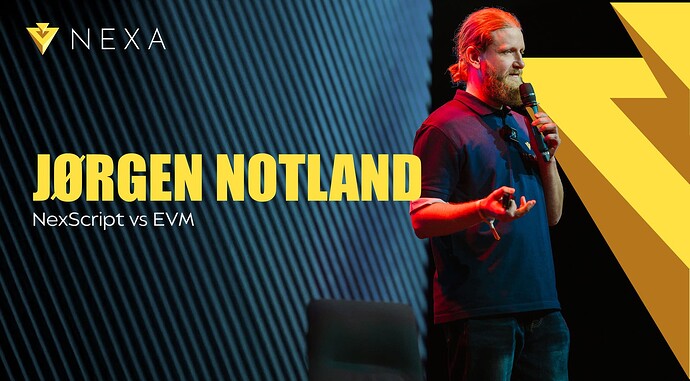Jørgen Notland presents at Web3 Amsterdam on 14 March 2025. Jørgen talks about how UTXO-based networks differ from EVM-based ones, and the distinctions between NexScript and Solidity.
Reviewing the fundamental structures and foundations of these architectures gives us a clear view of how Nexa differs from most common programmable EVM networks while still offering the same programmable capabilities. Additionally, Nexa has native tokens integrated into the protocol and validated by miners, eliminating the need for an exploitable smart contract layer for tokens. Nexa eliminates blind signing and addresses the issue of maximum extractable value (MEV), tackling some of the most common pain points in the industry.
Web3 Amsterdam Blockchain Conference, transcribed and adapted from a live speech.
Hello everyone, I’m Jørgen Notland, a developer at Nexa, and in this session I’d like to share some thoughts on how Nexa approaches smart contracts, especially in comparison to the Ethereum Virtual Machine (EVM). This talk is less about hype and more about practical design: what it means to build smart contracts that scale, are safe to use, and easy to reason about.
From Bitcoin to Nexa: The Evolution of Blockchain Architectures
To understand where Nexa fits in, it helps to look at the evolution of blockchain technology.
The first generation, led by Bitcoin, gave us decentralized money. Bitcoin’s design is elegantly simple, with a UTXO (Unspent Transaction Output) model and a limited scripting language. It’s secure and robust, but not very programmable.
The second generation, notably Ethereum, introduced smart contracts. These are programs that run on the blockchain, enabling a wide range of decentralized applications. Ethereum uses an account-based model and a Turing-complete virtual machine, the EVM.
Today, the Nexa team are building part of what is arguably the third generation of blockchain. This is where smart contracts become native, scalable, and practical for real-world systems. Like Bitcoin, Nexa is still UTXO-based, but the team has taken the model much further.
What Is NexScript?
NexScript is Nexa’s smart contract system. It builds on the simplicity of Bitcoin Script but expands it in powerful ways to allow for flexible logic, native token handling, and massive scalability.
One of the core principles behind NexScript is determinism. That means every smart contract execution can be predicted exactly. Before a transaction is included in a block, the outcome of its logic is fully known. There’s no uncertainty, no hidden state, and no surprises.
This deterministic nature also enables parallel execution. Since NexScript contracts don’t rely on global state or side effects, they can be validated independently and in parallel—making Nexa highly scalable without needing complex Layer 2 solutions.
Another major difference from Ethereum is that tokens in Nexa are native. In Ethereum, tokens are just smart contracts, lines of code that define balances and transfers. In Nexa, token logic is built into the system itself. This makes tokens lighter, safer, and easier to work with.
Why Stateless and Script-Based Matters
Unlike the EVM, which is based on accounts and global state, NexScript uses a stateless, script-based model. Every piece of logic is embedded directly in the transaction. There’s no dependency on past transactions or blockchain state. This approach makes contracts much easier to reason about, test, and audit.
One important benefit of this model is no infinite loops. NexScript is intentionally not Turing-complete. While this might sound limiting, it’s actually a feature, it means smart contracts can’t accidentally run forever or consume unbounded resources. Instead, they run efficiently and predictably.
This also dramatically reduces the risk surface. Developers don’t have to worry about reentrancy attacks or complex gas estimation problems. They can build smart contracts with the confidence that they’ll behave exactly as intended, every time.
A Better Developer Experience
For developers, NexScript offers clarity and control. You can inspect the full logic of a contract simply by looking at the transaction. You can simulate it, verify it, and know in advance what it will do. That kind of transparency is rare in smart contract systems today.
NexScript is designed to support modular on-chain functionality. Features like token factories and liquidity systems concepts similar to Uniswap can be built directly into Nexa’s scripting system, without requiring a full virtual machine or additional layers of complexity.
Conclusion: A Fresh Take on Smart Contracts
Nexa isn’t trying to replicate Ethereum. Instead, we’re offering a fundamentally different approach, one that rethinks how smart contracts should work at the protocol level.
By embracing the UTXO model, focusing on determinism, and designing for scalability from the ground up, NexScript enables a new generation of decentralized applications that are efficient, secure, and easy to reason about.
Smart contracts don’t have to be complicated to be powerful. In Nexa, smart contracts can be both simple and scalable, and the team is excited to see what developers will build with this new model.
Thank you.
